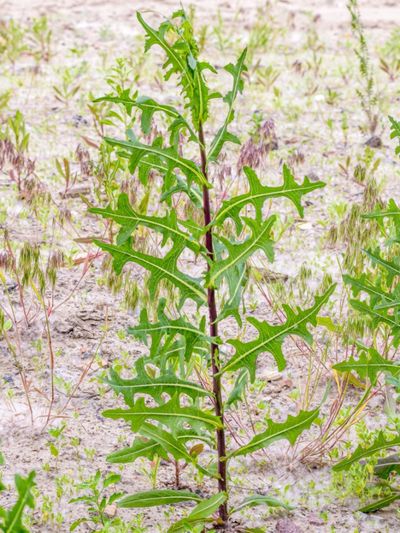What is Wild Lettuce?
Wild lettuce weeds are native to the Mediterranean and are also referred to as prickly lettuce, China lettuce, horse or milk thistle, wild opium and compass plant in relation to the north-south vertical placement of its leaves – perpendicular to direct sunlight. Wild lettuce, Lactuca serriola, is a biennial, sometimes an annual plant that prefers dry conditions but can be found in moist areas as well. The weed has a deep tap root that exudes a milky sap or latex that is known to clog farming equipment on commercial farms and may also sicken cattle. The plant is sometimes confused with dandelion in its rosette phase or for sow thistles at any stage of growth. All of these are members of the sunflower family, have a milky latex sap, and produce lots of viable wind dispersed seeds. Prickly lettuce weed is from 1-5 feet tall with alternating leaves that clasp the stem. Leaves are deeply notched with spiny margin along the mid-vein of the lower surface at maturity. Blossoms are yellow in color and about 1/3 inch across, blooming in late spring to early summer. A single plant can produce anywhere from 35 to 2,300 flowers, each containing around 20 seeds and adding up to a total of between 700 and 46,000 seeds per plant! Like dandelions, seeds of wild lettuce travel on air currents with the aid of downy, white plumes and are immediately viable or can survive 1 to 3 years in soil. The weed is most likely found in nurseries, orchards, along roadsides and amongst crops throughout the United States.
How to Get Rid of Wild Prickly Lettuce
Like pretty much all weeds, wild lettuce can be not only prolific but invasive. In commercial enterprises, prickly lettuce blossoms are difficult to remove from the grain and the latex sap not only gums ups farming equipment, but also inflates the moisture content of the grain. As such, most gardeners wonder about controlling prickly lettuce. Wild lettuce control for the home gardener with small invasions of the weed is good old fashioned hand pulling. Pull wild lettuce when the soil is damp and dig down to get all of the tap roots. Just as with dandelions, mowing over wild lettuce is not a long term control; the plant will just produce new stems and flowers. For large infestations and out on the farm, sheep and goats can effectively reduce the wild lettuce population. Chemical control for wild lettuce should be applied during the fall or spring. Herbicides should contain glyphosate, glufosinate or paraquat. Of the organic herbicide options, those that contain clove oil (eugenol) give the best results for wild lettuce control.
